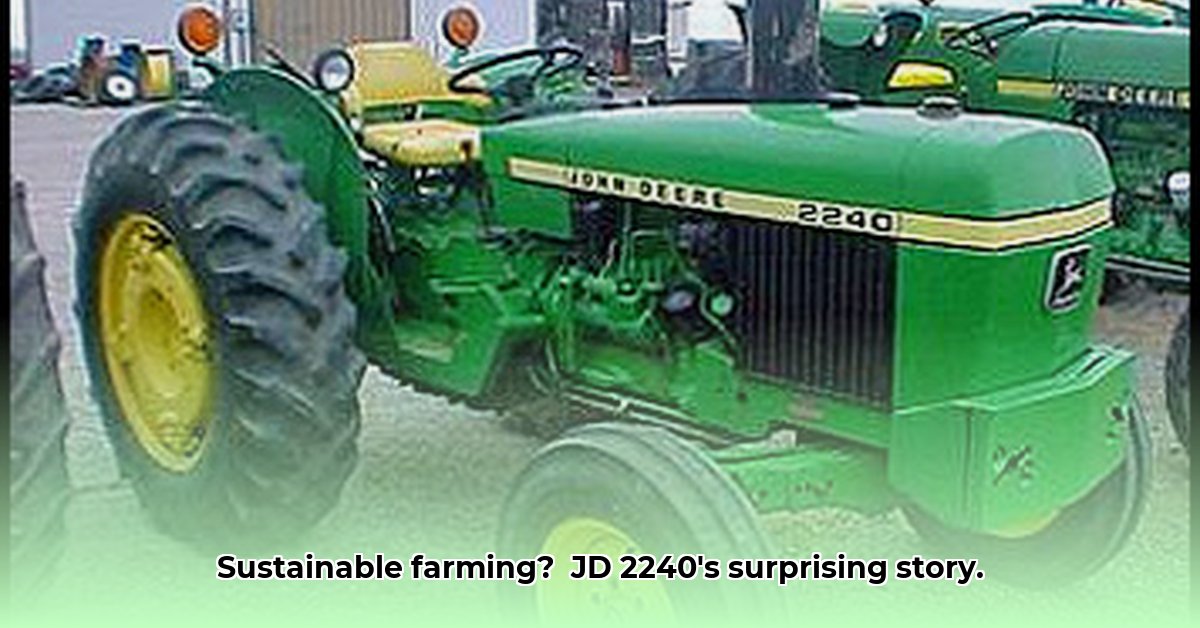
The JD 2240: A Closer Look
The John Deere 2240, produced from 1976 to 1982, represents a significant chapter in agricultural mechanization. This workhorse tractor, with its dependable build and horsepower ranging from 44 to 67 (depending on the specific model), served as the backbone of many farms. Its 16.5-gallon fuel tank, while smaller than modern equivalents, was adequate for many daily tasks. The available 8-speed and 16-speed transmissions showcased the technological advancements of the time, offering farmers choices to suit their operational needs. For a comparison with a later model, see this John Deere 6603. But how does this vintage machine fare against modern standards of efficiency and sustainability?
Fuel Efficiency and the Environment: A Balancing Act
Precise data on the JD 2240's fuel consumption per acre is scarce, hindering direct comparisons with modern tractors. While it's likely that the 2240 consumed more fuel per acre than its modern counterparts due to advancements in engine technology, quantifying this difference requires further research. Similarly, the 2240's two-wheel-drive system increased the risk of soil compaction compared to modern four-wheel-drive tractors. This soil compaction could negatively impact soil health and long-term crop yields. However, precisely quantifying the difference in soil health impact requires detailed research. How significant was the 2240's impact on soil health compared to the gains in efficiency seen with modern machines?
Maintaining a Legacy: Costs and Parts
Maintaining a JD 2240 presents unique challenges. Sourcing parts can be more difficult than for newer models. Finding specialized mechanics experienced with this older technology may also increase maintenance costs. The long-term economic viability depends on factors such as parts availability, local mechanic expertise, and the specific farming operation. While its simple design may mean fewer parts to potentially fail, the difficulty of obtaining replacements makes it a crucial consideration. Is the lower initial purchase price of a 2240 offset by the increased potential for costly repairs?
Comparing Apples and Oranges (or Tractors and Tractors)
The most significant difference between the JD 2240 and modern tractors lies in technology. Precision farming techniques like GPS guidance and yield monitoring systems were absent in the 2240's design. These modern advancements optimize resource use (fertilizers, pesticides), minimize soil disturbance, and improve efficiency. Modern tractors are better designed to mitigate soil compaction, promoting soil health and fuel efficiency. However, this technological advancement must also be viewed within the socio-economic context of 1970s and 1980s farming practices. Factors like farm size and available resources significantly influenced the overall sustainability of using a JD 2240. What compromises in efficiency were acceptable within the broader farming context of the 1970s and 1980s?
The JD 2240's Legacy: More Than Just Metal
The JD 2240's robust build and reliable performance earned it a lasting reputation. It served as a vital tool for countless farmers, shaping agricultural practices during its era. Yet, its legacy also highlights the remarkable progress in agricultural technology toward greater efficiency and sustainability. What aspects of the 2240's design and operation still hold relevance in contemporary sustainable agriculture practices?
Looking Ahead: Actionable Insights and Ongoing Research
The evolution from the JD 2240 to modern tractors underscores the need for continuous innovation in sustainable farming. Further research is crucial to fully quantify the environmental impact differences and comprehensively assess the various aspects of efficiency between vintage and modern tractors. This research should account for the socio-economic factors that influenced agricultural practices in each era.
Key Takeaways:
- The JD 2240's longevity and versatility are key strengths, especially in the context of smaller-scale farming.
- Its fuel inefficiency compared to modern tractors necessitates careful evaluation against operational needs and maintenance capabilities.
- A thorough pre-purchase inspection is crucial, focusing on potential weak points.
- Understanding the trade-off between lower initial costs and higher potential maintenance expenses is fundamental for responsible decision-making.
How to Compare John Deere 2240 Fuel Efficiency to Modern Tractors
Assessing the 2240's fuel consumption relative to modern tractors requires a nuanced approach. Direct comparisons using only fuel consumption rates are flawed without considering workload, operational conditions, and the technological context of its era and its different design priorities.
Practical Approaches:
- Gather Data: Obtain documented fuel consumption figures for a modern tractor working under comparable conditions.
- Estimate 2240 Consumption: Experienced owners or mechanics can provide estimates based on their experience with the model.
- Account for Variables: Consider output per fuel unit (e.g., acres plowed per gallon), not just liters per hour.
- Consider Total Cost of Ownership (TCO): Factor in purchase price, fuel, and maintenance costs.
The 2240's longevity and reduced manufacturing impact offer sustainability advantages that must be weighed against its lower fuel efficiency. A complete analysis needs to understand the trade-offs between this historical tractor and its modern counterparts.